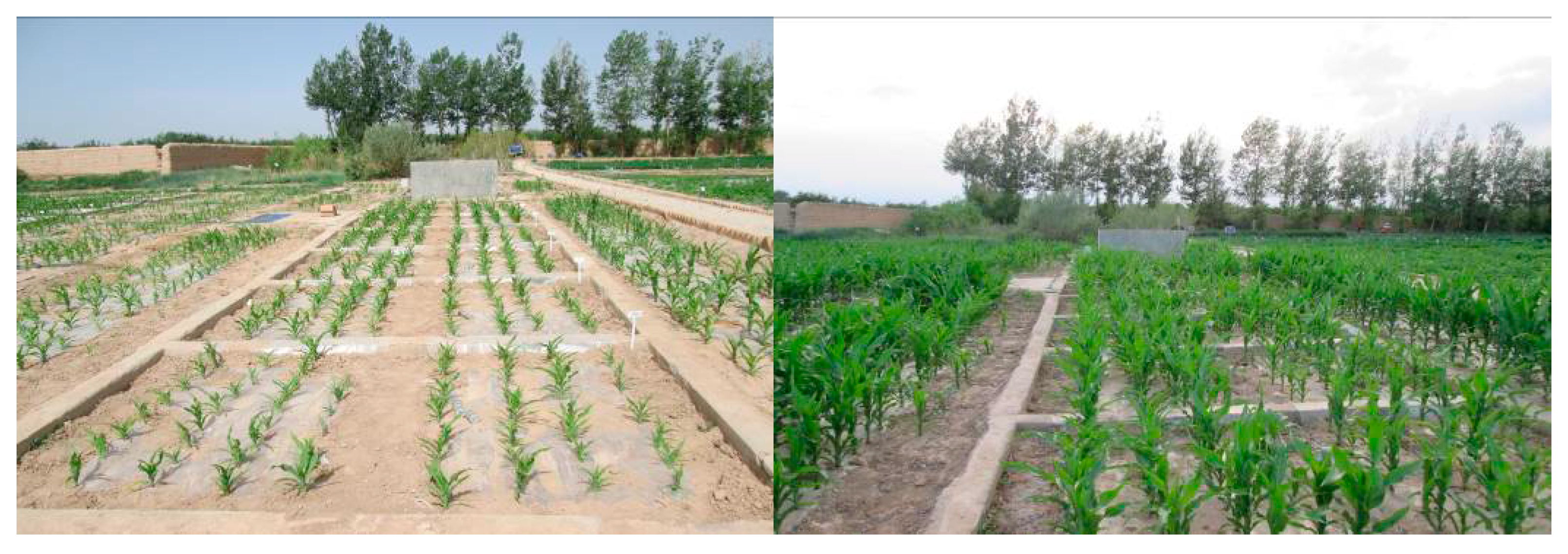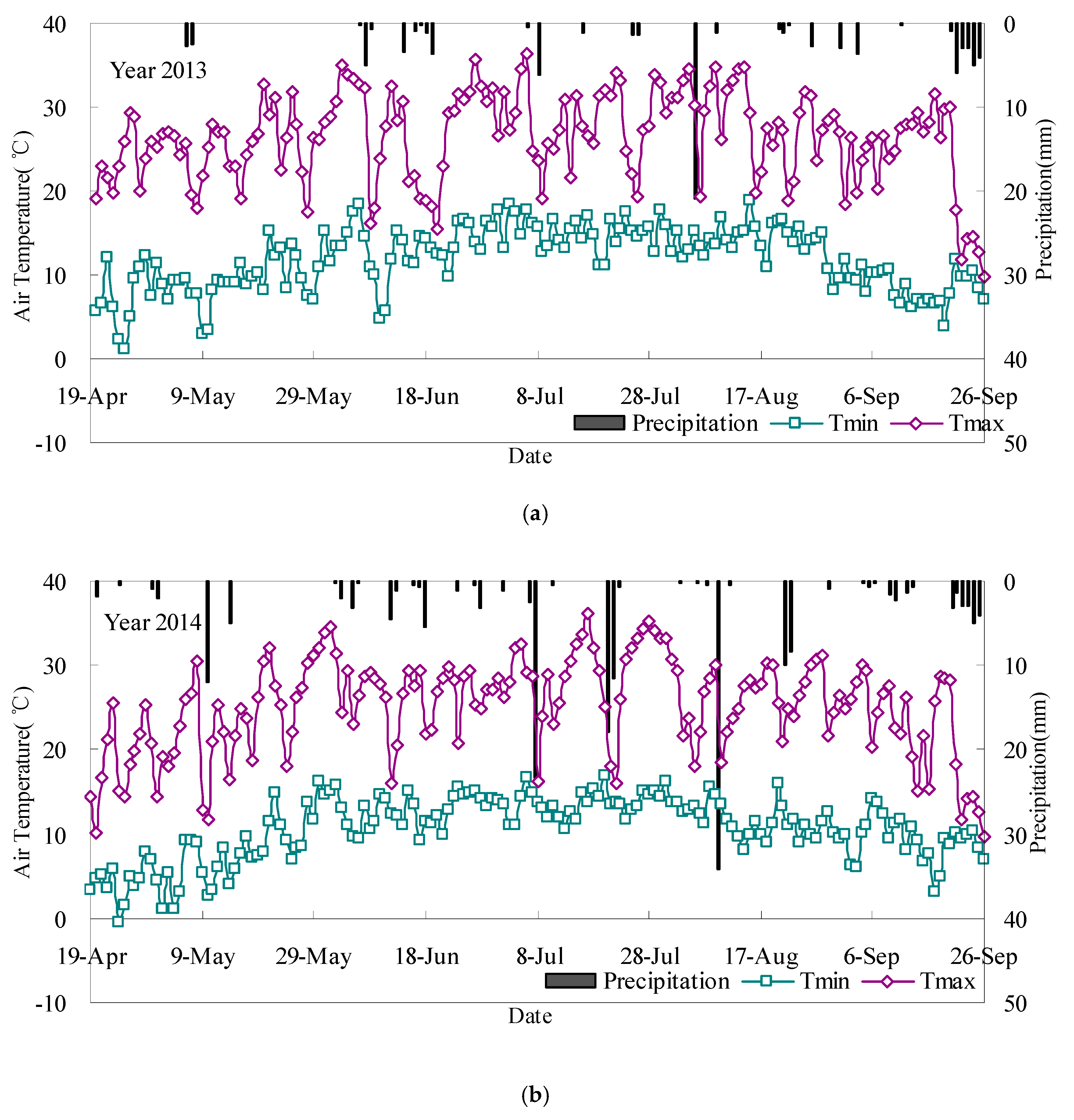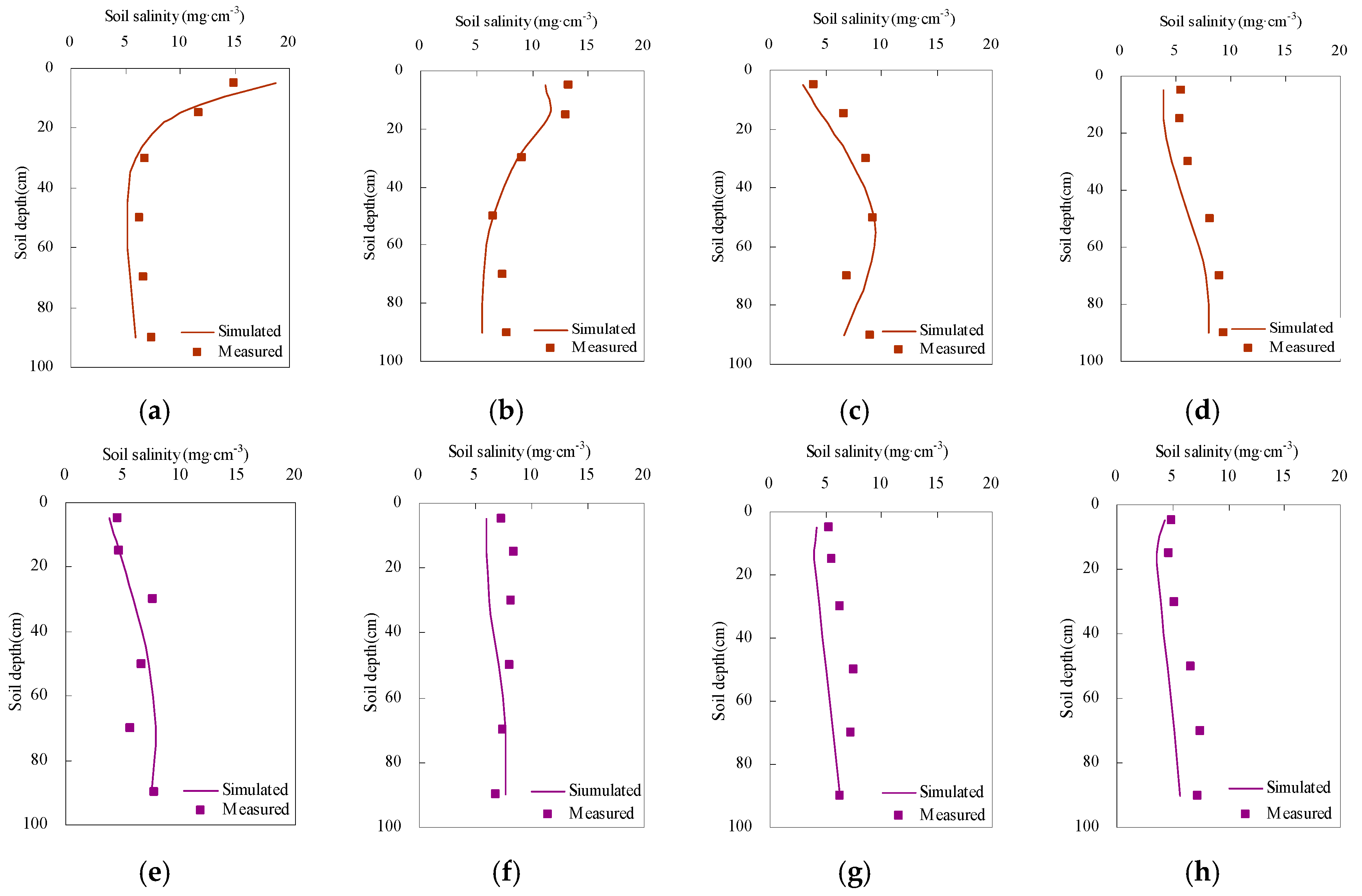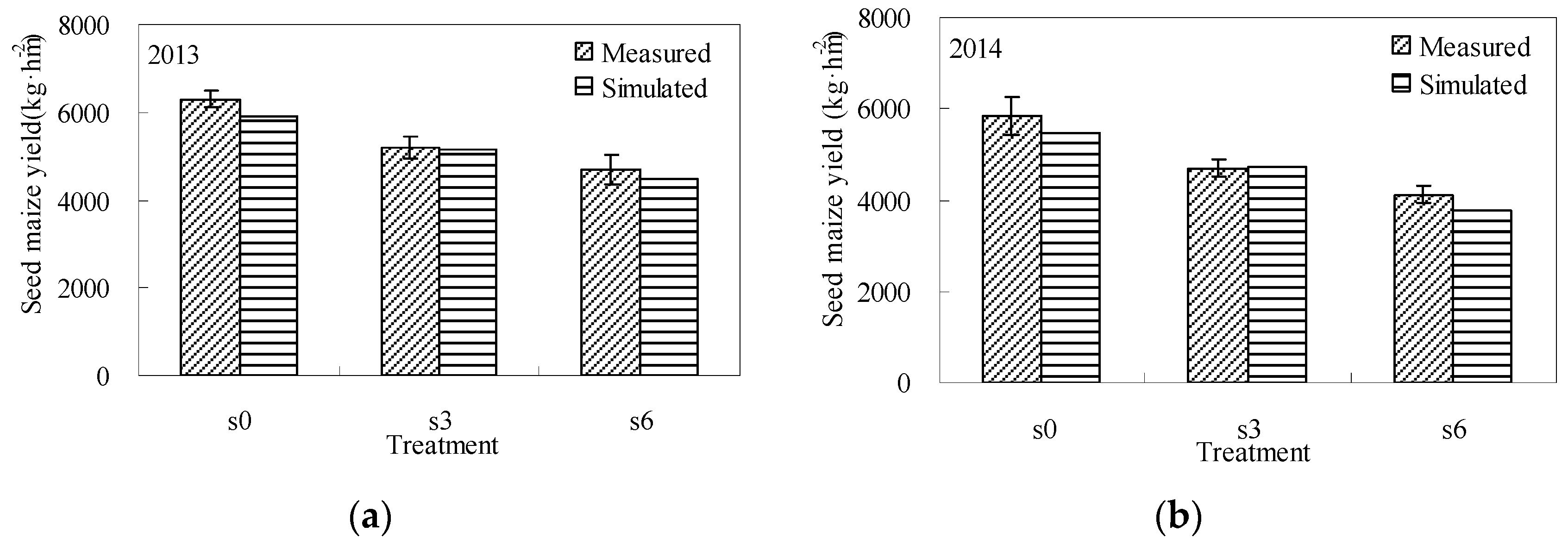Simulation of Saline Water Irrigation for Seed Maize in Arid Northwest China Based on SWAP Model
Abstract
:1. Introduction
2. Materials and Methods
2.1. Field Experiments
2.2. SWAP Model
3. Results and Discussion
3.1. Calibration and Validation of SWAP Model
3.2. Simulation of Saline Water Irrigation with Different Water Salinity on Soil Water–Salt Transport and Maize Yield
3.3. Long-Term Simulation for Soil Salinity Transport and Maize Yield
4. Conclusions
Author Contributions
Funding
Acknowledgments
Conflicts of Interest
References
- Chen, Y.N.; Yang, Q.; Luo, Y.; Shen, Y.J.; Pan, X.L.; Li, L.H.; Li, Z.Q. Ponder on the issues of water resources in the region of northwest China. Arid Land Geogr. 2012, 35, 1–9. [Google Scholar]
- Tian, F.Q.; Wen, J.; Hu, H.C.; Ni, G.H. Review on water and salt transport and regulation in drip irrigated fields in arid regions. J. Hydraul. Eng. 2018, 49, 126–135. [Google Scholar]
- Huo, H.X.; Zhang, J.G. Advance and prospects of research on soil salt movement under saline irrigation. Water Sav. Irrig. 2015, 4, 41–45. [Google Scholar]
- Wang, Y.J.; Qin, D.H. Influence of climate change and human activity on water resources in arid region of northwest China: An Overview. Clim. Chang. Res. 2017, 13, 483–493. [Google Scholar] [CrossRef]
- Wan, S.Q.; Kang, Y.H.; Wang, D.; Liu, S.P. Effect of saline water on cucumber (Cucumis sativus L.) yield and water use under drip irrigation in north china. Agric. Water Manag. 2010, 98, 105–113. [Google Scholar] [CrossRef]
- Singh, A.; Panda, S.N. Effect of saline irrigation water on mustard (Brassica juncea) crop yield and soil salinity in a semi-arid area of North India. Exp. Agric. 2012, 48, 99–110. [Google Scholar] [CrossRef]
- Mondal, M.K.; Bhuiyan, S.I.; Franco, D.T. Soil salinity reduction and prediction of salt dynamics in the coastal rice lands of Bangladesh. Agric. Water Manag. 2001, 47, 9–23. [Google Scholar] [CrossRef]
- Ma, W.J.; Mao, Z.Q.; Yu, Z.R.; van Mensvoort, M.E.F.; Driessen, P.M. Effects of saline water irrigation on soil salinity and yield of winter wheat-maize in North China Plain. Irrig. Drain. Syst. 2008, 22, 3–18. [Google Scholar] [CrossRef]
- Wu, Z.D.; Wang, Q.J. Effect on characteristics of soil water and salt movement about saline water infiltration with different infiltration amount. Trans. Chin. Soc. Agric. Mach. 2010, 41, 67–78. [Google Scholar]
- Feikema, P.M.; Morris, J.D.; Connell, L.D. The water balance and water sources of a Eucalyptus plantation over shallow saline groundwater. Plant Soil 2010, 332, 429–449. [Google Scholar] [CrossRef]
- Li, C.; Lei, J.; Zhao, Y.; Xu, X.; Li, S. Effect of saline water irrigation on soil development and plant growth in the Taklimakan desert highway shelterbelt. Soil Tillage Res. 2015, 146, 99–107. [Google Scholar] [CrossRef]
- Van Dam, J.C.; Huygen, J.; Wesseling, J.G.; Feddes, R.A.; Kabat, P.; Walsum, P.E.V.; Groenendijk, P.; van Diepen, C.A. Theory of SWAP Version 2.0; Simulation of Water Flow, Solute Transport and Plant Growth in the Soil-Water-Atmosphere-Plant Environment; DLO Winand Staring Centre: Wageningen, The Netherlands, 1997; pp. 1–167. [Google Scholar]
- Schahbazian, N.; Eitzinger, J.; Montazar, A.; Akbari, G.; Allahdadi, I. Using simulation models to improve irrigation water application. Pak. J. Water Resour. 2007, 11, 43–57. [Google Scholar]
- Singh, U.K.; Ren, L.; Kang, S. Simulation of soil water in space and time using an agro-hydrological model and remote sensing techniques. Agric. Water Manag. 2010, 97, 1210–1220. [Google Scholar] [CrossRef]
- Verma, A.K.; Gupta, S.K.; Isaaca, R.K. Use of saline water for irrigation in monsoon climate and deep water table regions: Simulation modeling with SWAP. Agric. Water Manag. 2012, 115, 186–193. [Google Scholar] [CrossRef]
- Verma, A.K.; Gupta, S.K.; Isaac, R.K. Calibration and validation of SWAP to simulate conjunctive use of fresh and saline irrigation waters in semi-arid regions. Environ. Model. Assess. 2014, 19, 45–55. [Google Scholar] [CrossRef]
- Yang, S.Q.; Ye, Z.G.; Shi, H.B.; Lan, L.T. Simulation and prediction of rotational irrigation with salty and fresh water in the Hetao irrigation area of Inner Mongolia. Trans. Chin. Soc. Agric. Eng. 2010, 26, 8–17. [Google Scholar]
- Kumar, P.; Sarangi, A.; Singh, D.K.; Parihar, S.S.; Sahoo, R.N. Simulation of salt dynamics in the root zone and yield of wheat crop under irrigated saline regimes using SWAP model. Agric. Water Manag. 2015, 148, 72–83. [Google Scholar] [CrossRef]
- Jiang, J.; Feng, S.; Huo, Z.; Zhao, Z.; Jia, B. Application of the swap model to simulate water-salt transport under deficit irrigation with saline water. Math. Comput. Model. 2011, 54, 902–911. [Google Scholar] [CrossRef]
- Jiang, J.; Feng, S.; Ma, J.; Huo, Z.; Zhang, C. Irrigation management for spring maize grown on saline soil based on SWAP model. Field Crops Res. 2016, 196, 85–97. [Google Scholar] [CrossRef]
- Wang, Q.M.; Huo, Z.L.; Zhang, L.D.; Wang, J.H.; Zhao, Y. Impact of saline water irrigation on water use efficiency and soil salt accumulation for spring maize in arid region of China. Agric. Water Manag. 2016, 163, 125–138. [Google Scholar] [CrossRef]
- Li, S.E.; Kang, S.Z.; Li, F.S.; Zhang, L. Evapotranspiration and crop coefficient of spring maize with plastic mulch using eddy covariance in Northwest China. Agric. Water Manag. 2008, 97, 1214–1222. [Google Scholar] [CrossRef]
- Doorenbos, J.; Kassam, A.H. Yield Response to Water. FAO Irrigation and Drainage Paper 33; FAO: Rome, Italy, 1979. [Google Scholar]
- Ma, Y.; Feng, S.Y.; Song, X.F. Evaluation of optimal irrigation scheduling and groundwater recharge at representative sites in the North China Plain with SWAP model and field experiments. Comput. Electron. Agric. 2015, 116, 125–136. [Google Scholar] [CrossRef]
- Jiang, X.; Kang, S.; Tong, L.; Li, F. Modification of evapotranspiration model based on effective resistance to estimate evapotranspiration of maize for seed production in an arid region of Northwest China. J. Hydrol. 2016, 538, 194–207. [Google Scholar] [CrossRef]
- Ben-Asher, J.; van Dam, J.; Feddes, R.A.; Jhorar, R.K. Irrigation of grapevines with saline water: II. Mathematical simulation of vine growth and yield. Agric. Water Manag. 2006, 83, 22–29. [Google Scholar] [CrossRef]
- Wu, Z.D.; Wang, Q.J. Effect of saline water continuous irrigation on winter wheat yield and soil physicochemical property. Trans. Chin. Soc. Agric. Mach. 2010, 41, 36–43. [Google Scholar]
- Crescimanno, G.; Garofalo, P. Management of irrigation with saline water in cracking clay soils. Soil Sci. Soc. Am. J. 2006, 70, 1774–1787. [Google Scholar] [CrossRef]
- Martínez-Ferri, E.; Muriel-Fernández, J.L.; Rodríguez Díaz, J.A. Soil water balance modelling using SWAP: An application for irrigation water management and climate change adaptation in citrus. Outlook Agric. 2013, 42, 93–102. [Google Scholar] [CrossRef]
- Sarwar, A.; Bastiaanssen, W.G.M.; Feddes, R.A. Irrigation water distribution and long-term effects on crop and environment. Agric. Water Manag. 2001, 50, 125–140. [Google Scholar] [CrossRef]
- Tedeschi, A.; Menenti, M. Simulation studies of long-term saline water use: Model validation and evaluation of schedules. Agric. Water Manag. 2002, 54, 123–157. [Google Scholar] [CrossRef]










| Soil Depth (cm) | Sand (%) | Silt (%) | Clay (%) | Organic Content (g/kg) | Soil bulk Density (g/cm3) | Field Capacity (cm3/cm3) | Saturated Water Content (cm3/cm3) | International Soil Texture |
|---|---|---|---|---|---|---|---|---|
| 0–20 | 61.03 | 28.43 | 10.54 | 2.60 | 1.49 | 0.27 | 0.36 | Sandy loam |
| 20–40 | 58.33 | 30.45 | 11.22 | 2.64 | 1.54 | 0.30 | 0.40 | Sandy loam |
| 40–100 | 53.11 | 34.14 | 12.75 | 5.69 | 1.55 | 0.32 | 0.42 | Clay loam |
| Treatment | Irrigation Water Salinity (mg/cm3) | Irrigation Water Quota (mm) | Overall Irrigation Water Quota (mm) | ||||
|---|---|---|---|---|---|---|---|
| 5 June | 30 June | 20 July | 10 August | 29 August | |||
| s0 | 0.71 | 120 | 120 | 105 | 105 | 105 | 555 |
| s3 | 3.0 | 120 | 120 | 105 | 105 | 105 | 555 |
| s6 | 6.0 | 120 | 120 | 105 | 105 | 105 | 555 |
| Soil Depth (cm) | Residual Water Content (cm3/cm3) | Saturated Water Content (cm3/cm3) | Saturated Hydraulic Conductivity (cm/d) | Shape Factor α (/cm) | Shape Factor n | Shape Factor γ |
|---|---|---|---|---|---|---|
| 0–20 | 0.044 | 0.36 | 32.57 | 0.024 | 1.434 | 0.5 |
| 20–40 | 0.043 | 0.38 | 29.85 | 0.024 | 1.417 | 0.5 |
| 40–100 | 0.049 | 0.40 | 13.71 | 0.011 | 1.480 | 0.5 |
| Soil Depth (cm) | Residual Water Content (cm3/cm3) | Saturated Water Content (cm3/cm3) | Saturated Hydraulic Conductivity (cm/day) | Shape Factor α (/cm) | Shape Factor n | Shape Factor γ |
|---|---|---|---|---|---|---|
| 0–20 | 0.055 | 0.34 | 30.81 | 0.024 | 1.402 | 0.5 |
| 20–40 | 0.044 | 0.38 | 31.66 | 0.022 | 1.408 | 0.5 |
| 40–100 | 0.095 | 0.39 | 12.00 | 0.020 | 1.310 | 0.5 |
| Irrigation Water Salinity (mg/cm3) | Water Balance | Salt Balance | Yield (kg/hm2) | Water Use Efficiency (kg/m3) | ||||||
|---|---|---|---|---|---|---|---|---|---|---|
| Irrigation (mm) | Rainfall and Interception (mm) | Soil Water Change (mm) | Bottom Flux (mm) | Evapotranspiration (mm) | From Irrigation (mg/cm2) | Bottom Flux (mg/cm2) | Increase in Soil (mg/cm2) | |||
| 0.71 | 450 | 108.7 | −107.8 | −118.1 | 548.4 | 31.95 | −35.95 | −4.00 | 5546.96 | 1.01 |
| 1.0 | 450 | 108.7 | −103.9 | −120.3 | 542.3 | 45.00 | −36.75 | 8.25 | 5483.92 | 1.01 |
| 2.0 | 450 | 108.7 | −91.0 | −129.9 | 519.8 | 90.00 | −40.67 | 49.33 | 5168.76 | 1.00 |
| 3.0 | 450 | 108.7 | −80.7 | −142.4 | 497.0 | 135.00 | −46.61 | 88.39 | 4853.59 | 0.98 |
| 4.0 | 450 | 108.7 | −73.0 | −157.1 | 474.6 | 180.00 | −55.19 | 124.81 | 4538.42 | 0.96 |
| 5.0 | 450 | 108.7 | −67.3 | −173.6 | 452.4 | 225.00 | −66.86 | 158.14 | 4286.28 | 0.95 |
| 6.0 | 450 | 108.7 | −62.8 | −190.7 | 430.8 | 270.00 | −81.49 | 188.51 | 3971.12 | 0.92 |
| 7.0 | 450 | 108.7 | −59.3 | −207.8 | 410.2 | 315.00 | −98.57 | 216.43 | 3718.98 | 0.90 |
| 8.0 | 450 | 108.7 | −56.4 | −224.4 | 390.7 | 360.00 | −117.80 | 242.20 | 3466.85 | 0.89 |
© 2019 by the authors. Licensee MDPI, Basel, Switzerland. This article is an open access article distributed under the terms and conditions of the Creative Commons Attribution (CC BY) license (http://creativecommons.org/licenses/by/4.0/).
Share and Cite
Yuan, C.; Feng, S.; Huo, Z.; Ji, Q. Simulation of Saline Water Irrigation for Seed Maize in Arid Northwest China Based on SWAP Model. Sustainability 2019, 11, 4264. https://doi.org/10.3390/su11164264
Yuan C, Feng S, Huo Z, Ji Q. Simulation of Saline Water Irrigation for Seed Maize in Arid Northwest China Based on SWAP Model. Sustainability. 2019; 11(16):4264. https://doi.org/10.3390/su11164264
Chicago/Turabian StyleYuan, Chengfu, Shaoyuan Feng, Zailin Huo, and Quanyi Ji. 2019. "Simulation of Saline Water Irrigation for Seed Maize in Arid Northwest China Based on SWAP Model" Sustainability 11, no. 16: 4264. https://doi.org/10.3390/su11164264
APA StyleYuan, C., Feng, S., Huo, Z., & Ji, Q. (2019). Simulation of Saline Water Irrigation for Seed Maize in Arid Northwest China Based on SWAP Model. Sustainability, 11(16), 4264. https://doi.org/10.3390/su11164264





